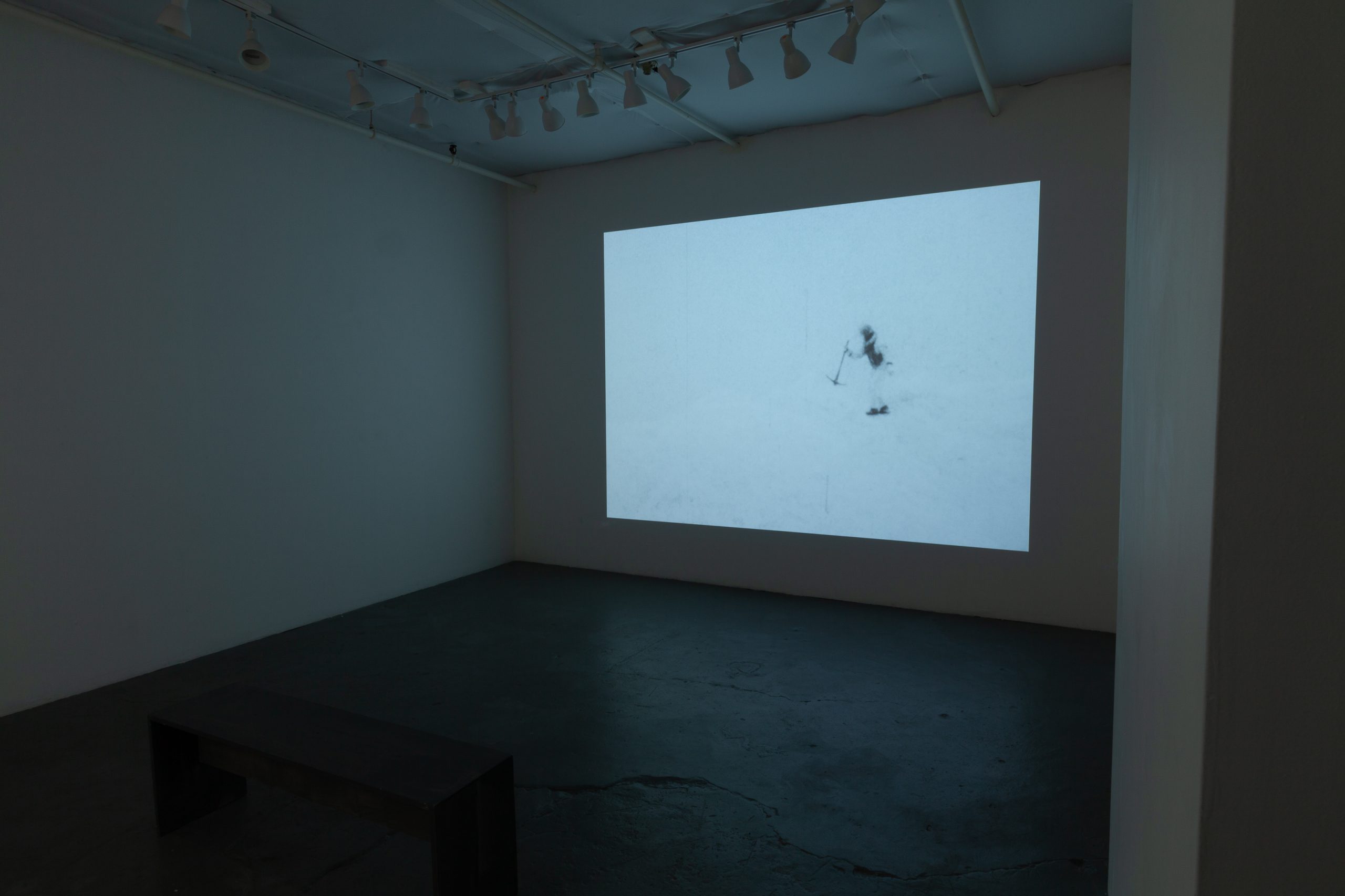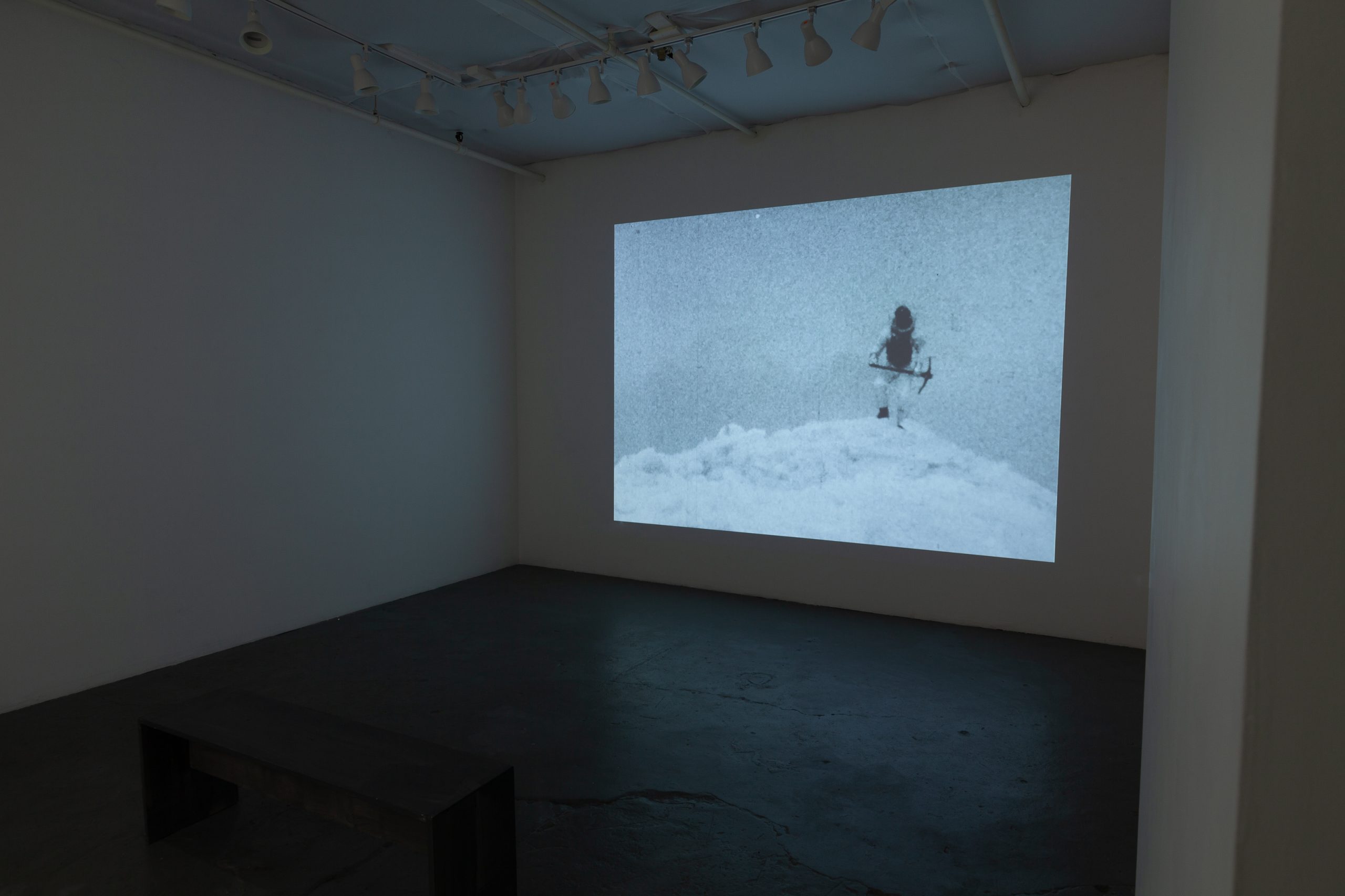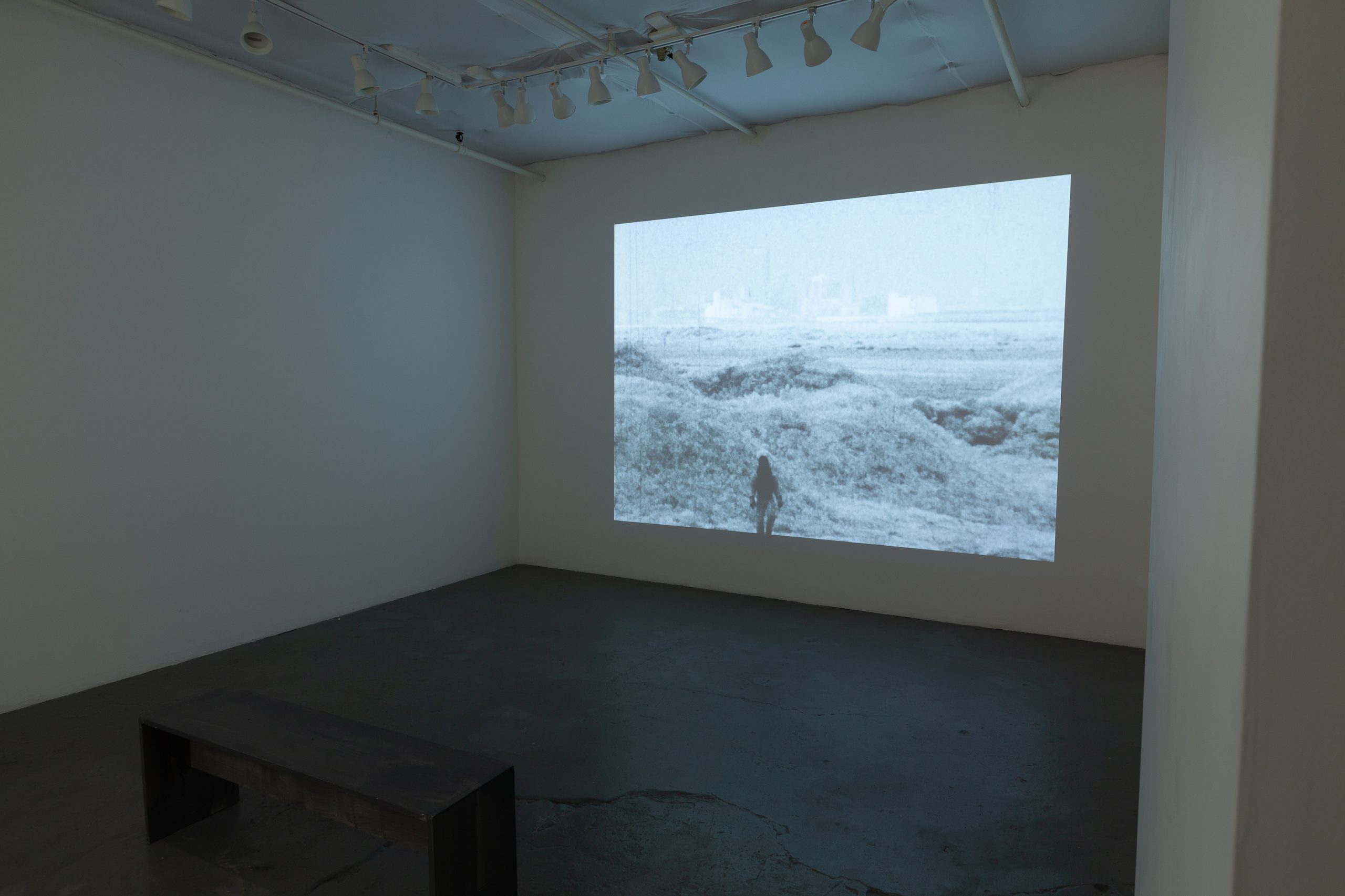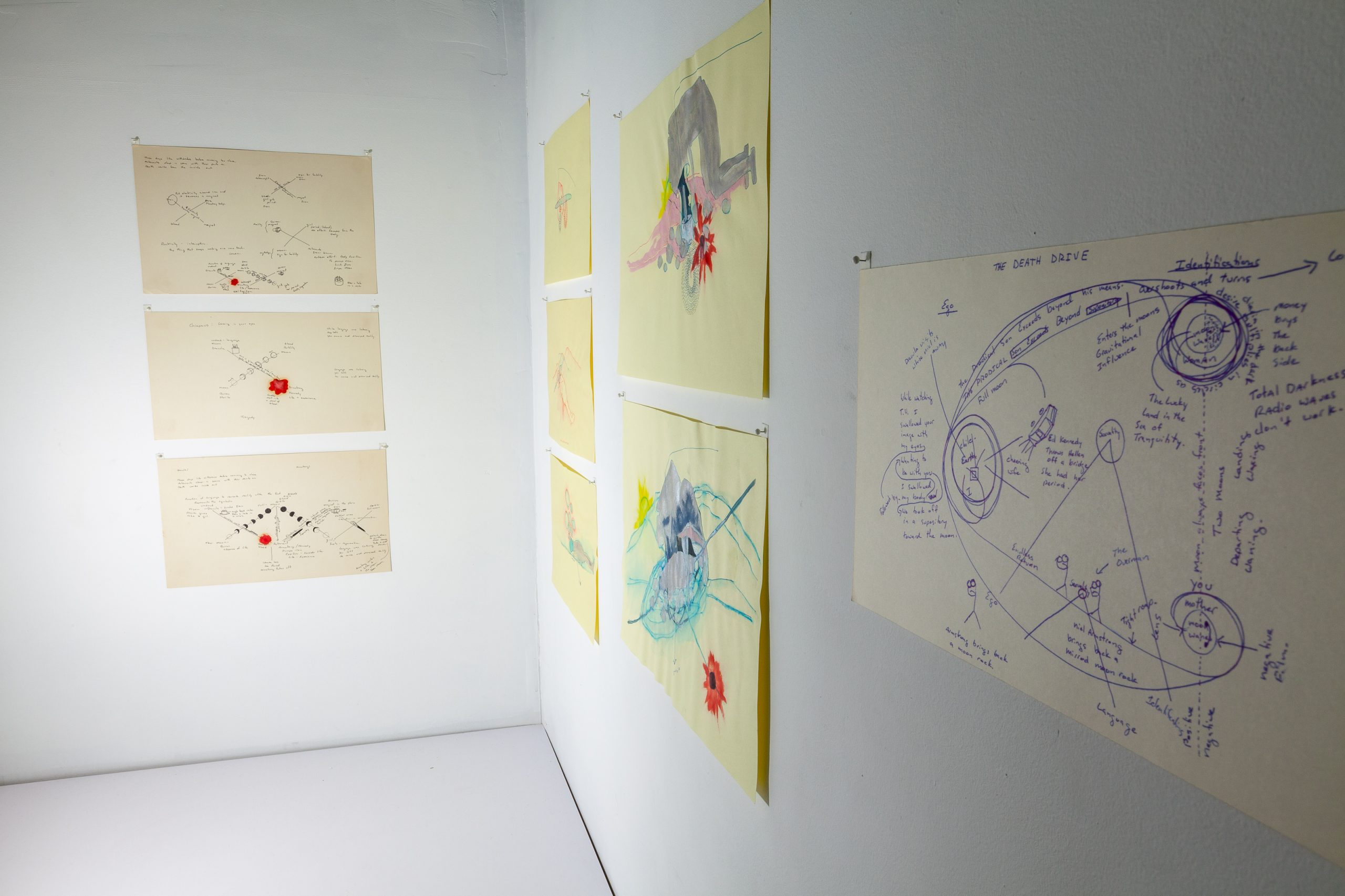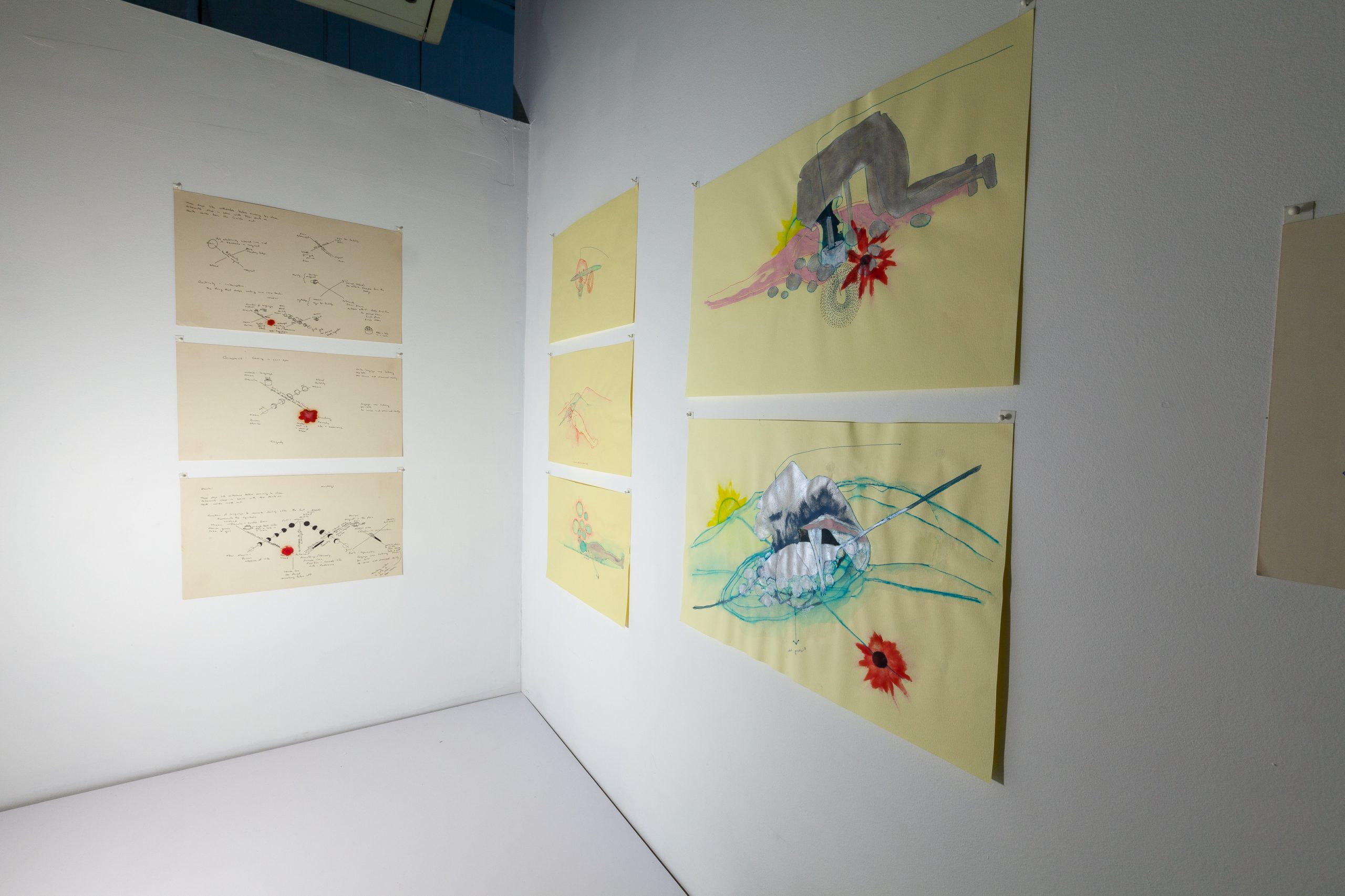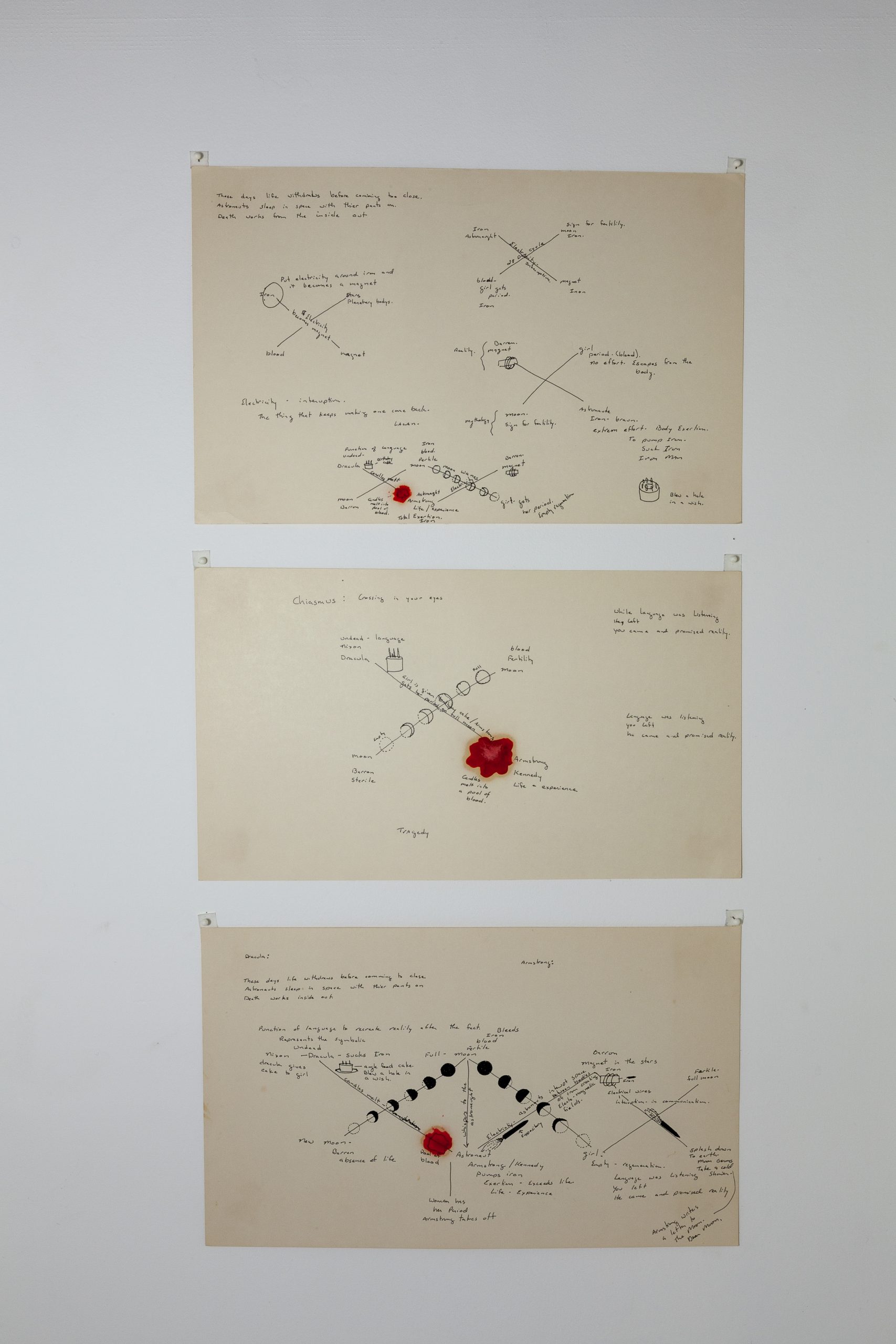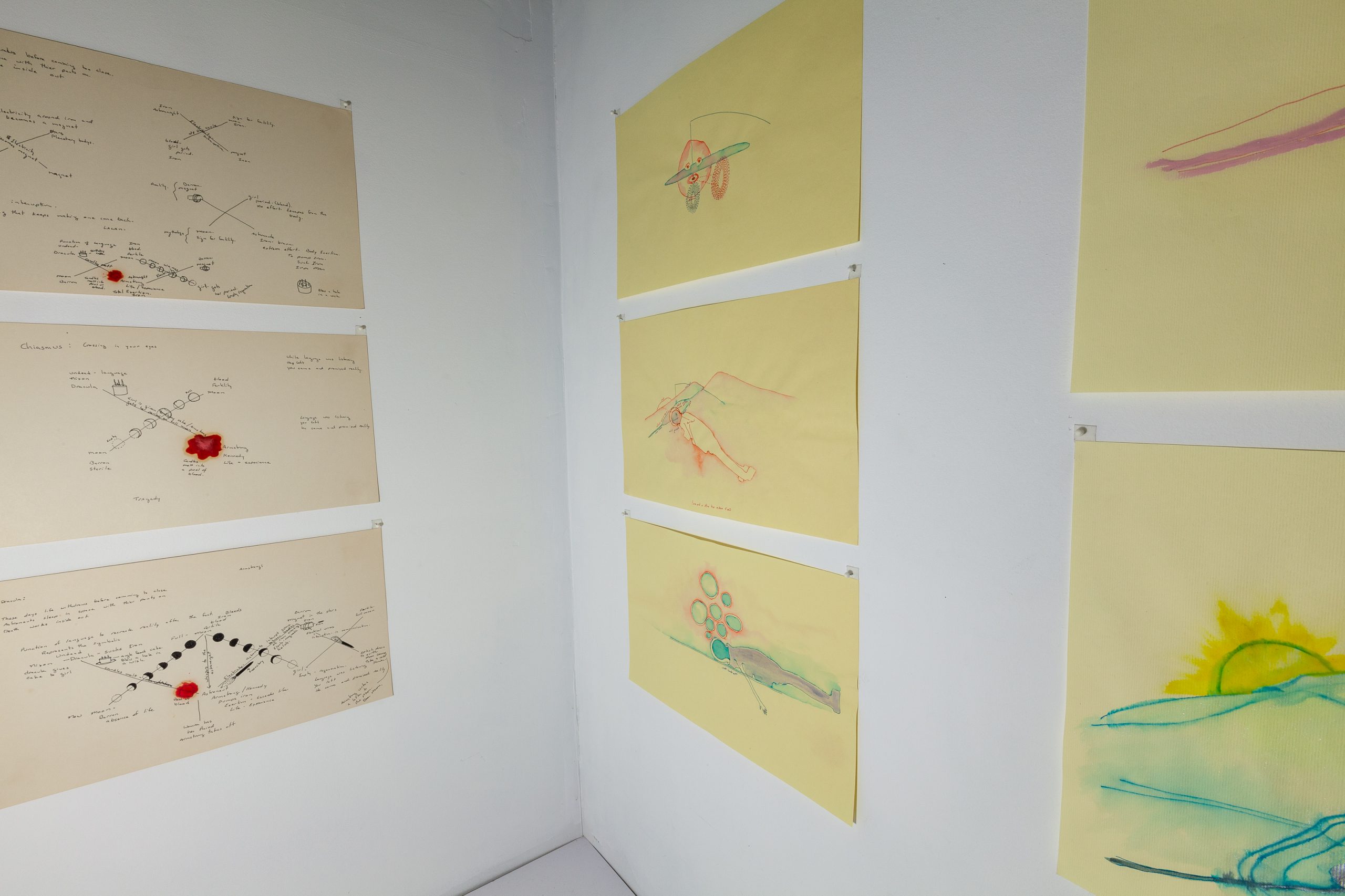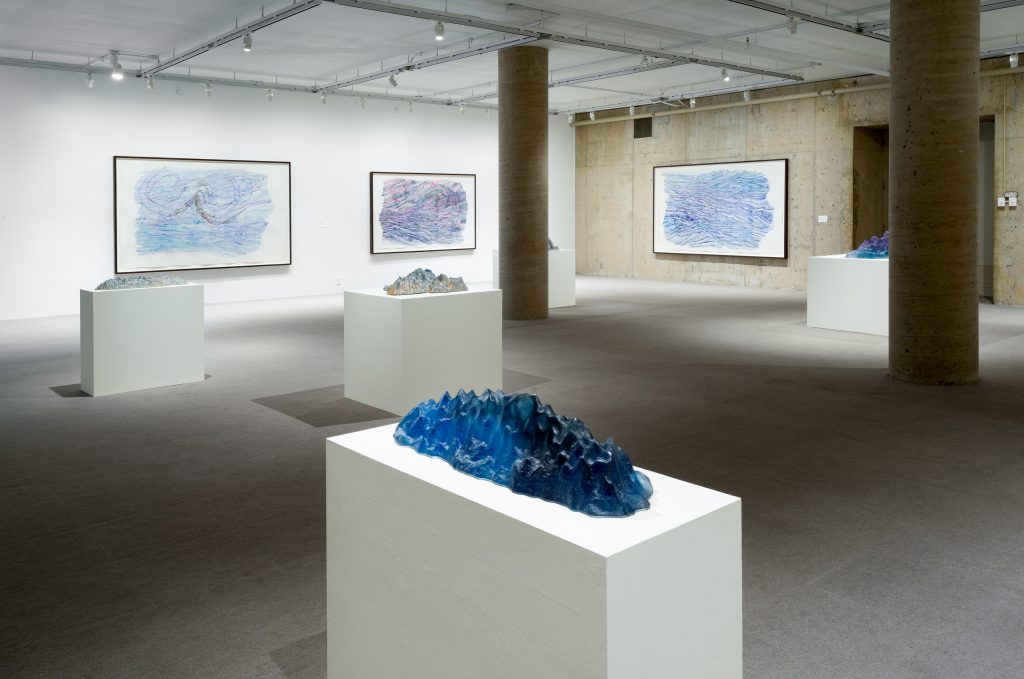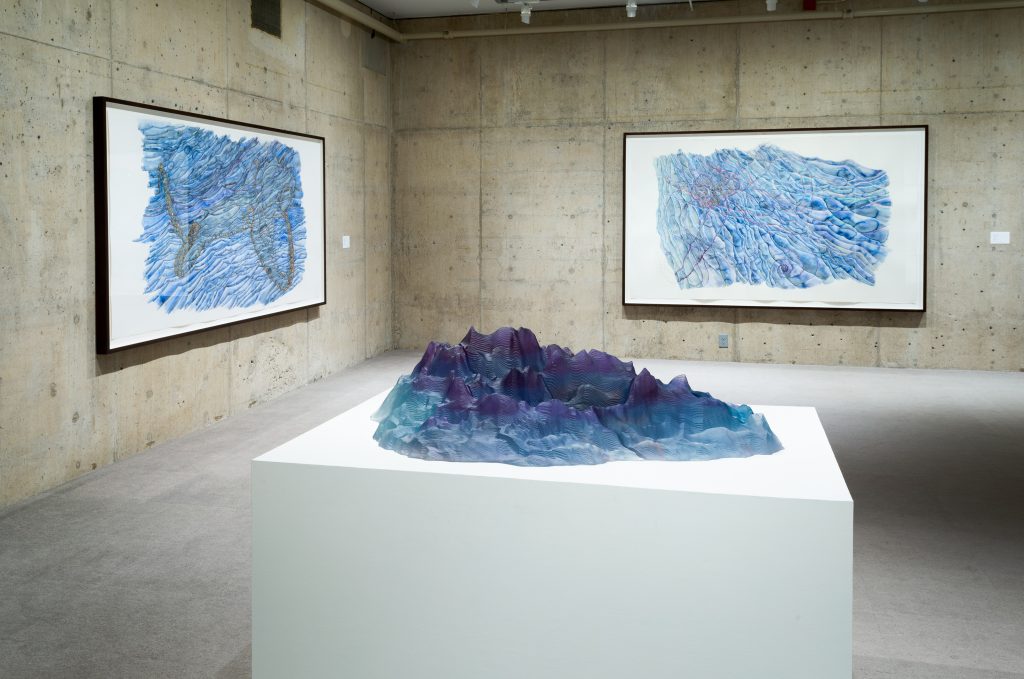Loominous Rugs, Loominous Rug Gallery
Providence, October 17, 2024
Invite

Installation View

Installation view of Katy Schimert’s Horseshoe Falls Rug, 2022, hand-knotted in wool and silk, 8 x 10 feet. Photo courtesy of Dee Speaks.
Individual Work

Photo credit: Karen Philippi
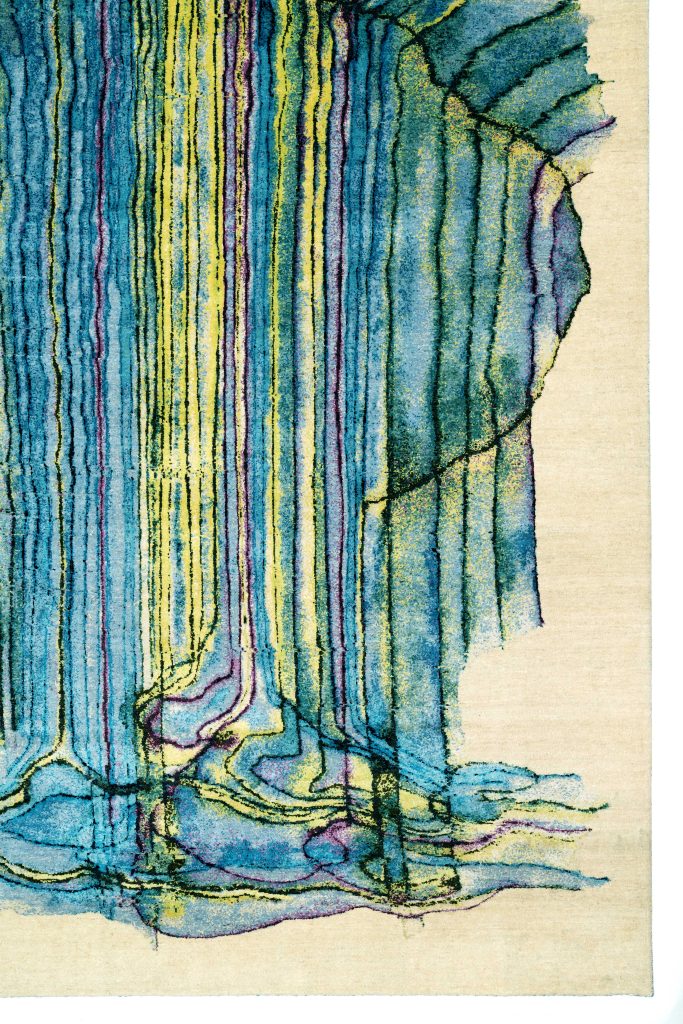
Process



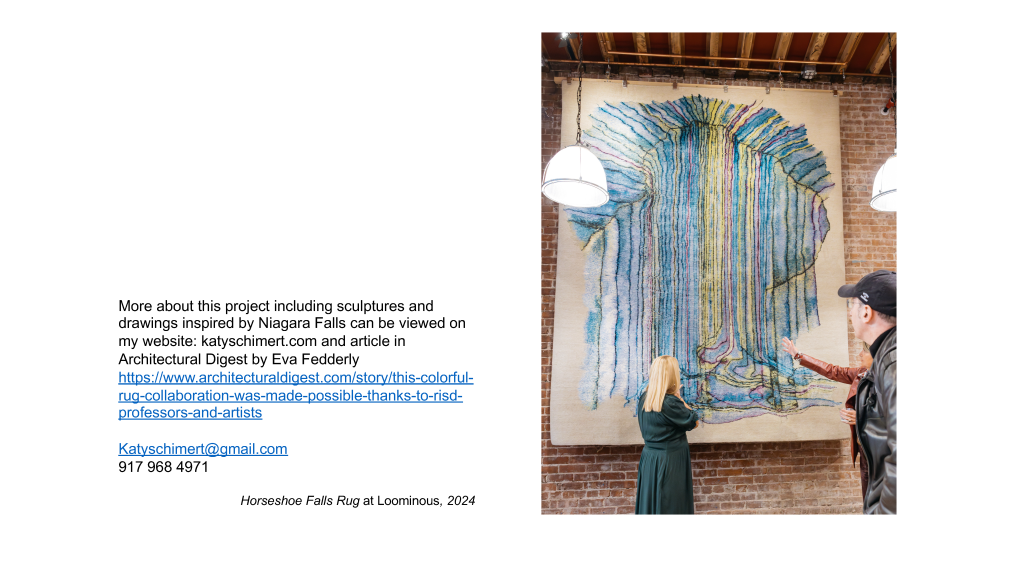
On the Grounds, Al Held Foundation
Boiceville, NY, May 11–October 13, 2024
Installation Views

All photos: Alon-Koppel



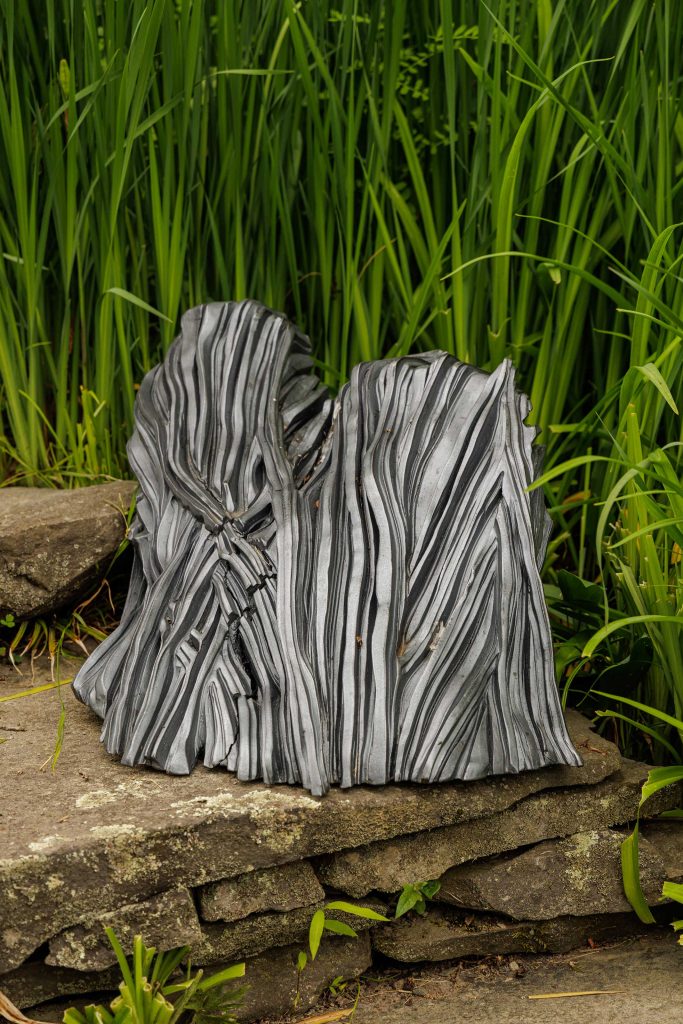
Armor, 2018, soda-fired stoneware,13 x 23 x 20 inches

Foreground: The Eye, 2024, glazed terra-cotta, 18.5 x 22 x 13 inches

Ripple, 2019, glazed soda-fired stoneware, 12.5 x 18 x 18 inches

Water, 2023, glazed terra-cotta, 16 x 28 x 19 inches

From top to bottom: White, 2024, glazed terra-cotta, 18 x 26 x 13 inches; Heart, 2024, glazed ceramic, 14 x 23 x 10 inches; Green American Falls, 2019, glazed terra-cotta, 16 x 15 x 17 inches

Installation view of With Caves, 2015, watercolor on paper, 12.5 x 15 inches. Mounted in Bull Barn over wall drawings by Sylvia Stone.

Installation view of Split Open with Sun, 2015, watercolor on paper, 12.5 x 15 inches (left) and With Falling Rocks and Caves, 2015, watercolor on paper, 12.5 x 15 inches (right). Mounted in Bull Barn over wall drawings by Sylvia Stone.
Press Release




Play with Form Until it has Impact, House of Tyres
New York, February 21–April 23, 2024
Installation Views
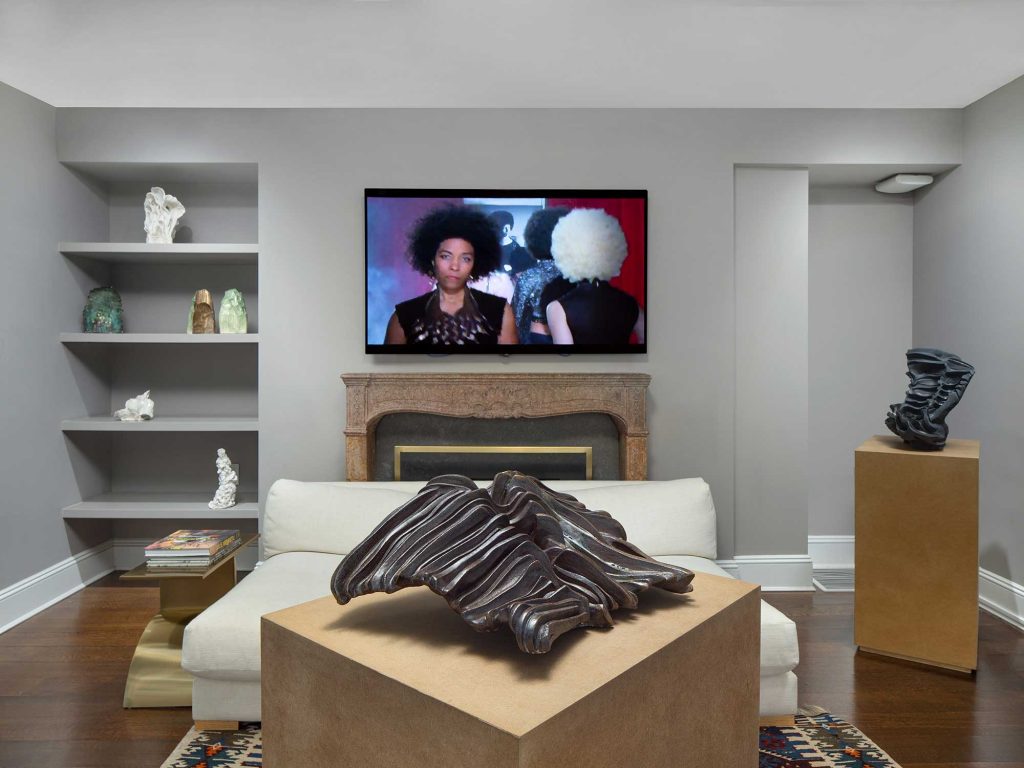
Left: Angel Chen, Center (video): Carrie Mae Weems, right and center (sculpture): Katy Schimert
Individual Works






Invite

Drawing as Practice, The National Academy of Design
New York, September 14 to December 16, 2023
Installation Views

Left to right: Katy Schimert, Thalassa and Hestia (ceramic sculptures), Dione and The Sea Resting Against the Earth (watercolor drawings), 2021; John Newman; Untitled, 2001; and Christine Sun Kim, Competing Languages, 2020. Photo: Etienne Ftossard
Individual Works
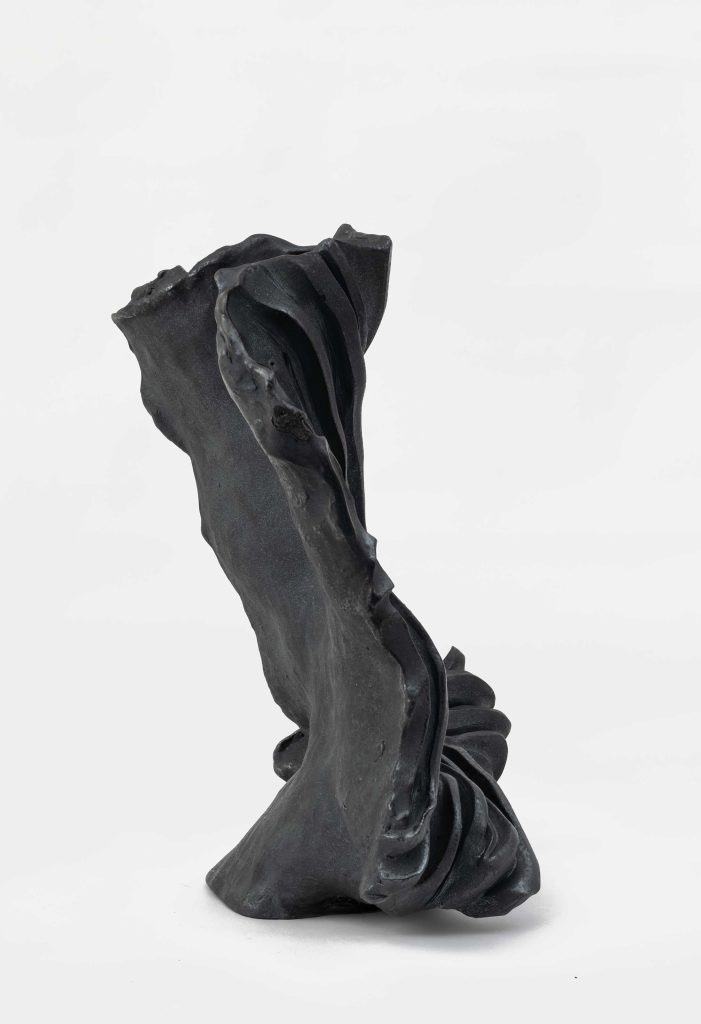


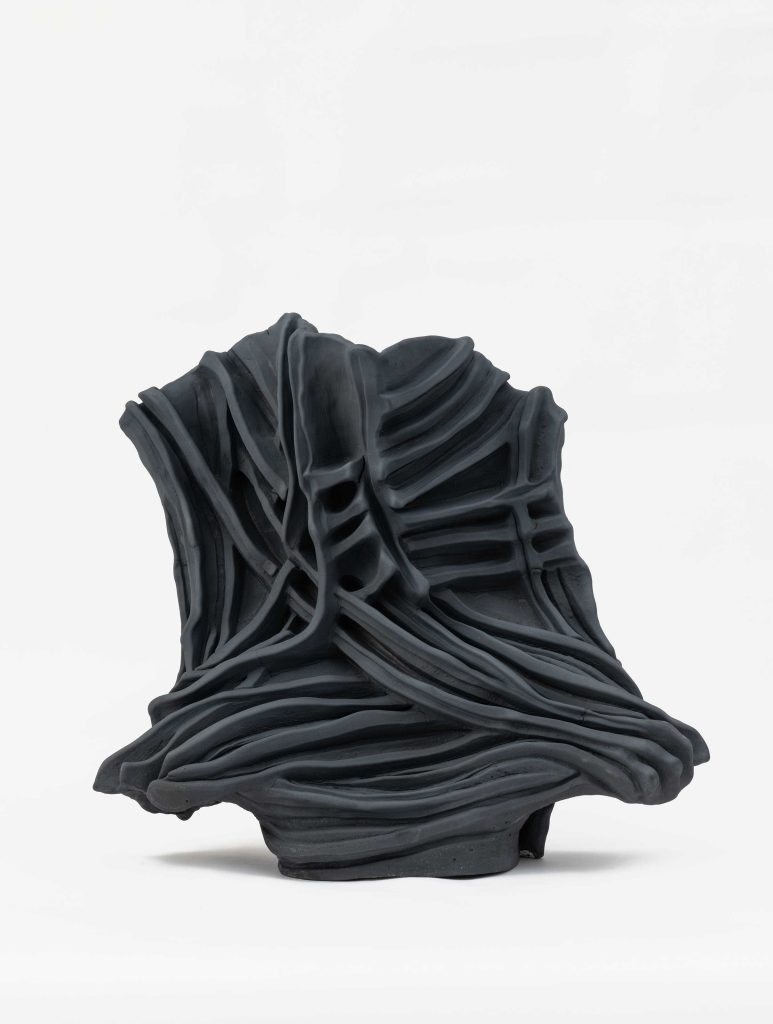
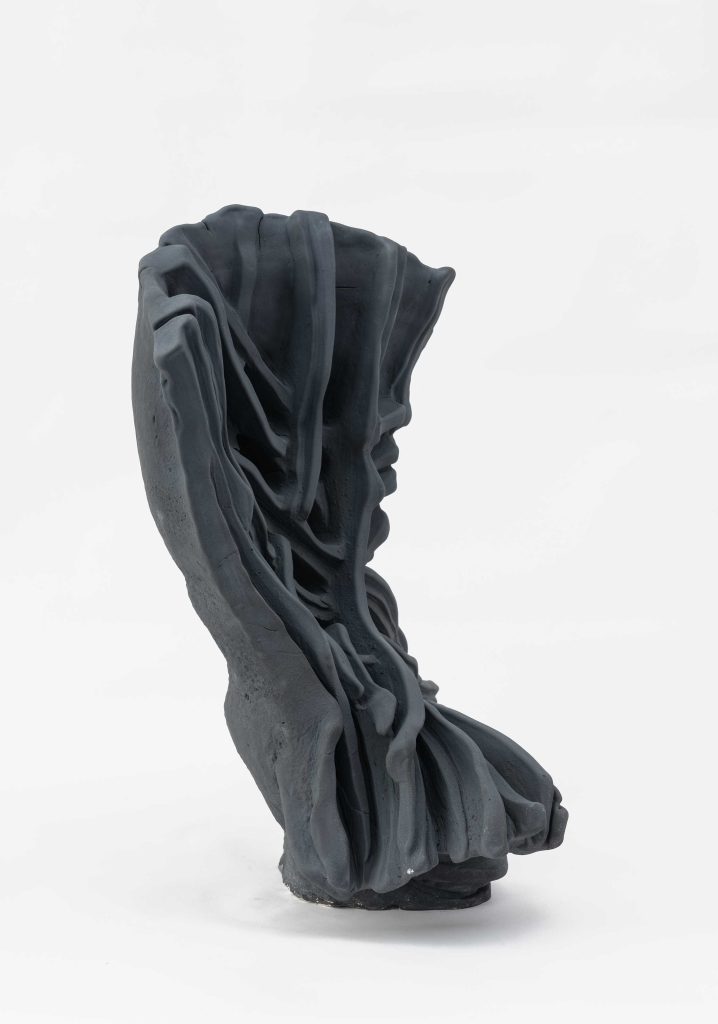

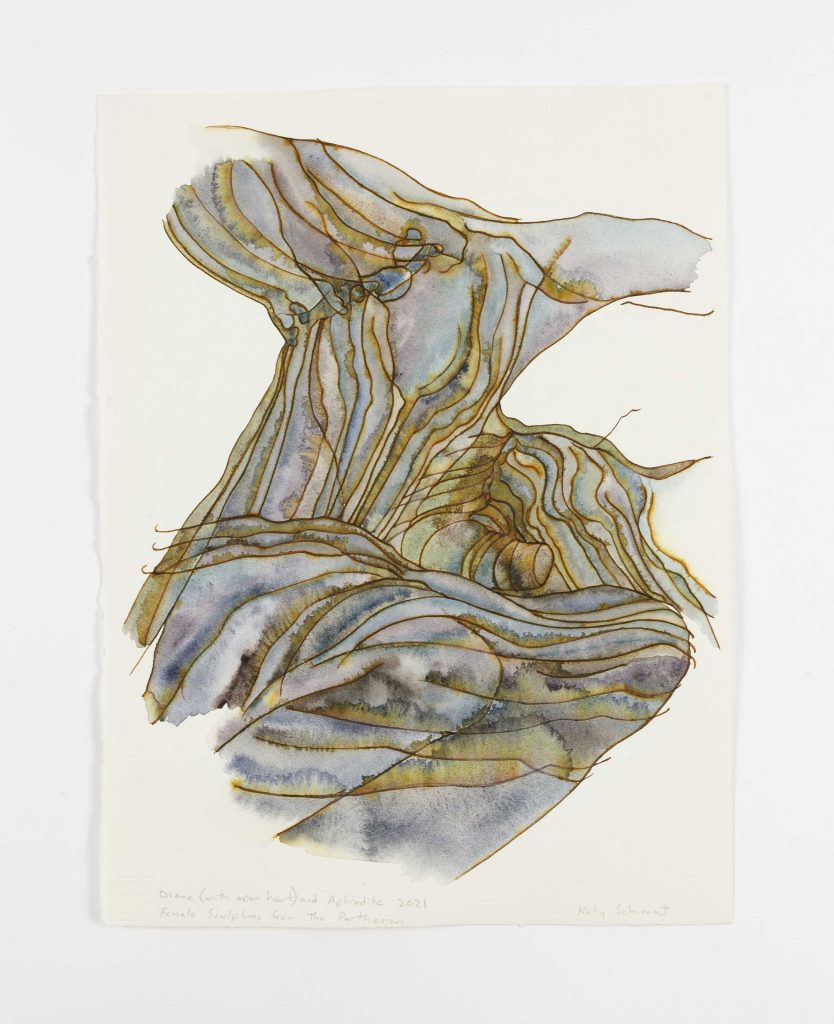


Press Release



Katy Schimert and Ping Zheng, Geary
Millerton, NY, August 12—October 1, 2023
Installation Views

Installation view of Katy Schimert and Ping Zheng, Geary, 2023

Installation view of Katy Schimert and Ping Zheng, Geary, 2023

Installation view of Katy Schimert and Ping Zheng, Geary, 2023

Left to right: Ping Zheng, Go with the Flow, 2022, oil stick on paper, 24 x 18 inches; Katy Schimert, With Falling Rocks and Caves, 2015, watercolor on paper, 13 x 15 inches; and With Ribbed Rocks, 2020, glazed terra-cotta, 16 x 23 x 16 inches

Left to right: Ping Zheng; Katy Schimert, American Falls, 2019, glazed ceramic, 21 x 24 x 17.5 inches; Ping Zheng, Flying, 2022 Ray of Sunlight, 2022, oil stick on paper, 14 x 11 inches.

Left to right: Katy Schimert, With Caves, 2015, watercolor on paper, 13 x 15 inches; Ping Zheng, Sunlit Path, 2022, oil stick on paper, 18 x 24 inches; Katy Schimert, Ripple, 2020, glazed soda-fired ceramic 12.5 x 18 x 18.

Left to right: Ping Zheng, Traveler, 2022, oil stick on paper, 18 x 22 inches; Katy Schimert, Painted American Falls, 2019, glazed ceramic 23 x 20 x 14 inches.

Left to right: Katy Schimert, With Caves, 2015, watercolor on paper, 13 x 15 inches; Ping Zheng, Sunlit Path, 2022, oil stick on paper, 18 x 24.
Individual Works









American Falls (large), 2019, glazed ceramic, 21 x 24 x 17.5 inches

Painted American Falls, 2019, glazed ceramic, 23 x 20 x 14 inches

With Caves, 2015, watercolor on paper, 12.5 x 15 inches

With Falling Rocks and Caves, 2015, watercolor on paper, 12.5 x 15 inches

Split Open with Sun, 2015, watercolor on paper, 12.5 x 15 inches
Press Release
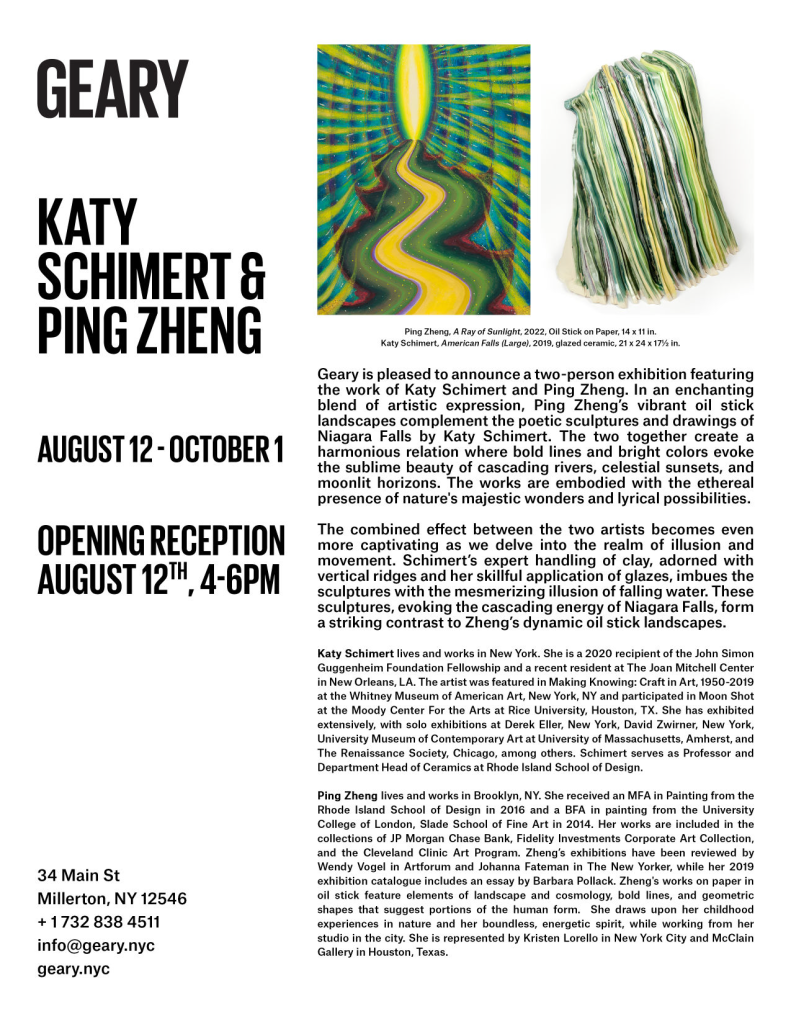
Reviews










Holding, Kristen Lorello and Van Doren Waxter
New York, NY, July 12–August 18, 2023
Installation Views


Individual Works


Press Release

Niagara, Derek Eller Gallery
New York, November 18–December 23, 2021
Installation Views
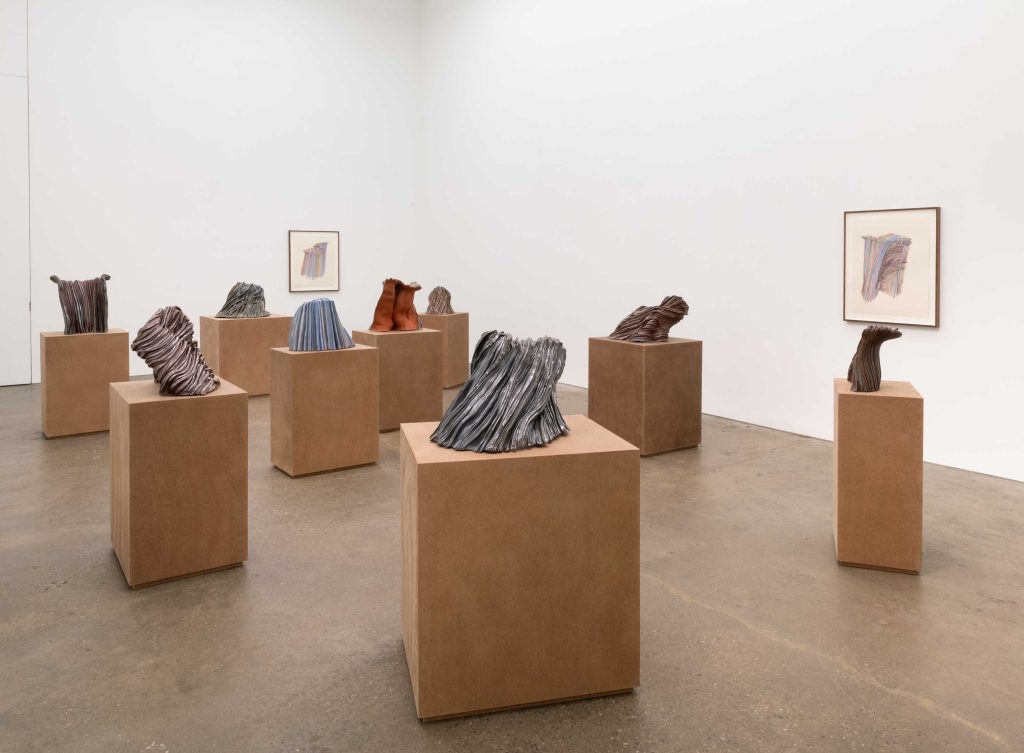




Individual Works



















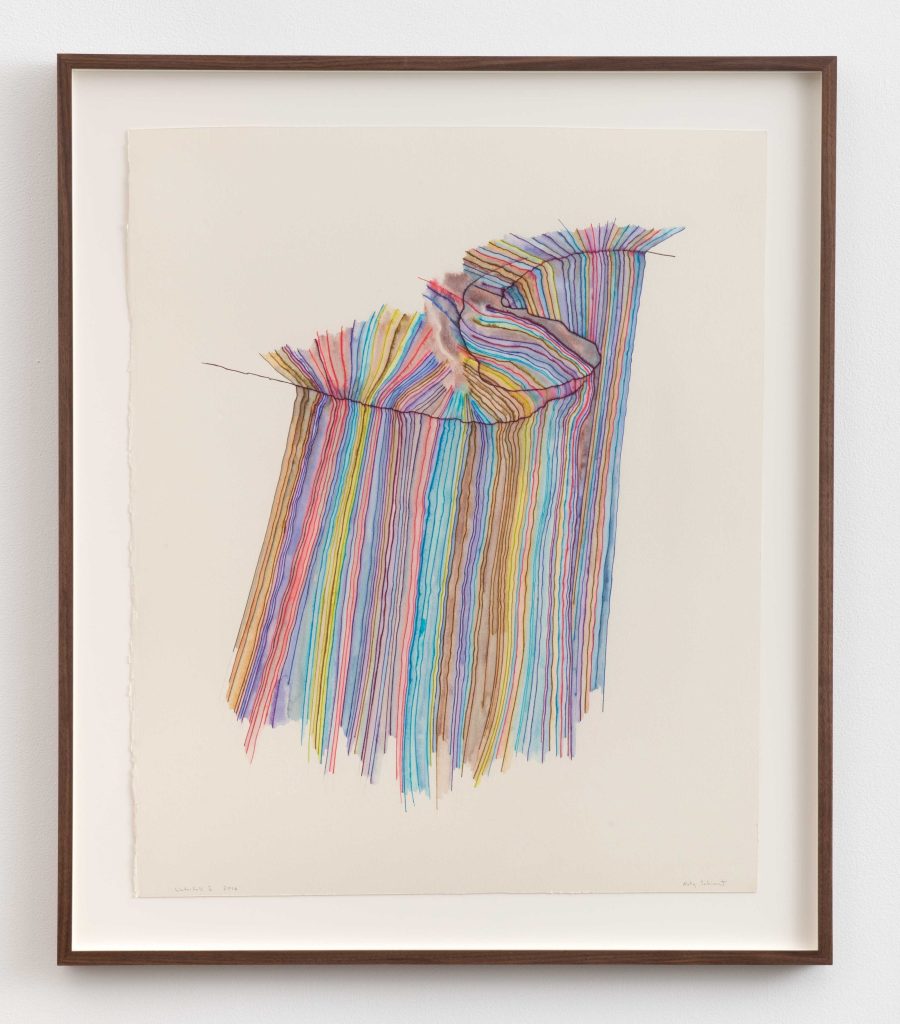


Press Release

currently on view, Yale University Art Gallery
New Haven, CT, 2021–ongoing
Introduction
Spine, 2021, is currently on View at the Yale University Art Gallery, New Haven, CT where it is part of the permanent collection.
Individual Works


Artists & Allies IV, Signs and Symbols
New York, Aug 1–Sept 30, 2021
Information
Icarus and the World trade Center, 1998
Katy Schimert with Josh Lucas
Camera: Saam Gabbay
In the ’90s, I had a studio on John Street near the World Trade Center. The towers were an ever-present male icon of power. But in the evening, as the sun would descend and creep between the two towers, a visual sunburn would appear, dissolving the towers’ edge, transforming the masculine structure into an elusive female form. Meditating upon the transformation, the jubilation of the rising market and the haunting presence of traders, I came to think of the Icarus Myth — the image of out-of-control ambition, of flying and falling figures. Icarus’s father, Daedalus, was an architect who built a labyrinth that eventually imprisoned both father and son, leading to the fashioning of wax wings and their escape. For me, the trading floor and the complexity of world markets became a contemporary, psychological labyrinth and a prison for an ambitious soul.
Icarus follows a series of super 8 films that I made with Saam Gabbay. The works were made like drawings; to explore the narrative and illusory aspect to my sculpture. I used what was available – inserting the protagonist into everyday scenes. Looking back many of the elements would be unavailable to a contemporary artist: the Trade Centers are gone and even if they were still here one would not be able to film in the plaza, the American Stock Exchange or in a parasail on the Hudson river without extensive funds and permits. Josh Lucas became a Hollywood star.
View Film

Film Stills




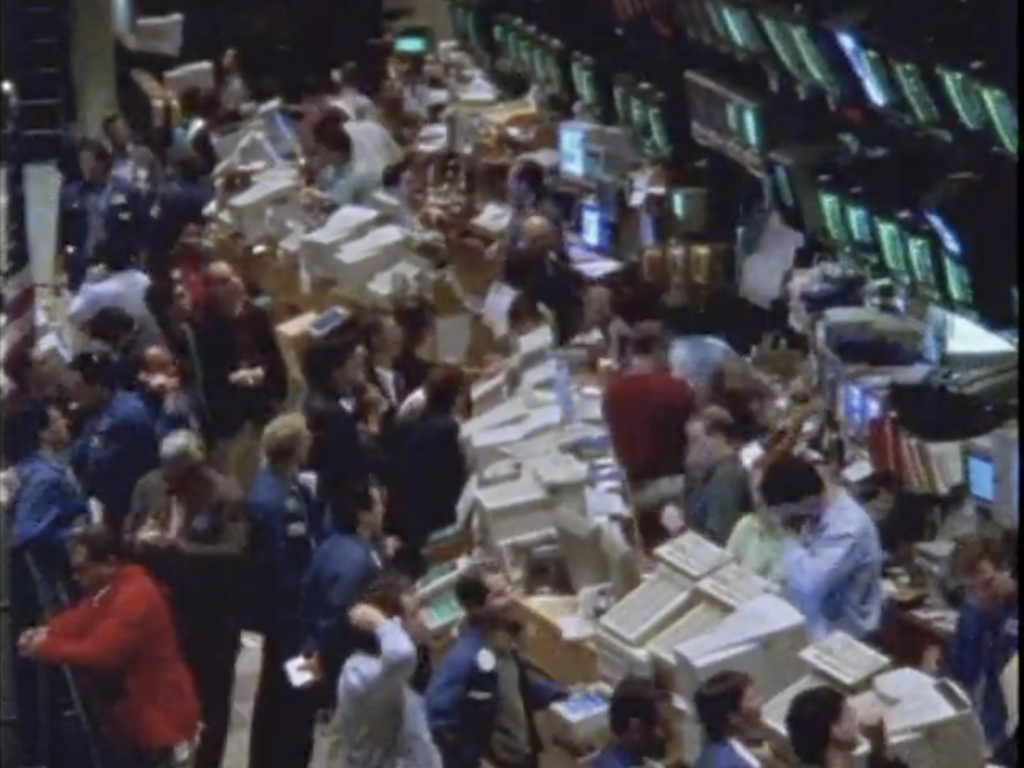
currently on view, RISD Museum
Providence, RI, 2018–ongoing
Introduction
Predator, 2015, is currently on View at the RISD Museum. This ceramic sculpture depicts the nuanced movement of water, capturing the depth and color of changing tides. It was produced using wooden molds, which were made by harnessing the precision of a computer-controlled (or CNC) router. The stoneware was cast using the molds, glazed, then fired in a wood kiln, which produced smoke and ash that affected the final appearance of the glaze. This juxtaposition of the intentional and volatile processes that yielded this work creates a complex dialogue between its form and surface.
Individual Works

Predator, 2015, stoneware with glaze, 27 x 20 x 7-1/2 inches (68.6 x 50.8 x 19.1 cm), photo courtesy of the RISD Museum, Providence, RI.
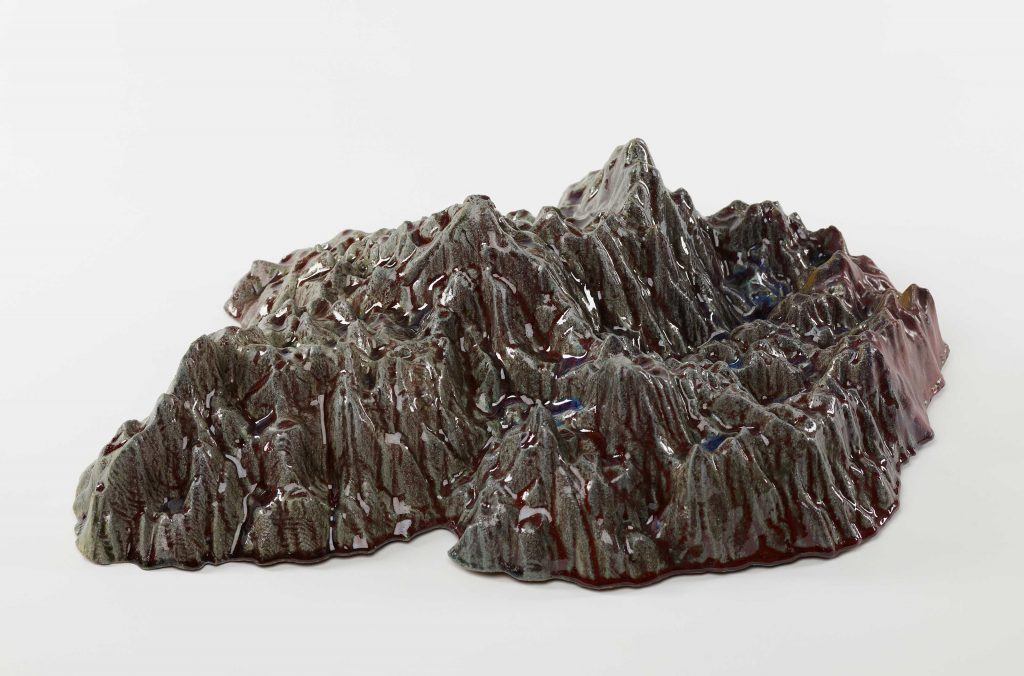

Making Knowing: Craft in Art, 1950–2019, Whitney Museum of American Art
New York, Nov 22, 2019–Feb 2022
Installation Views



Individual Work

Press Release



The Astronaut 1996, Black Ball Projects
Brooklyn, Sept 23–Nov 3, 2019
Exhibition Views
Film Excerpt

Press Release
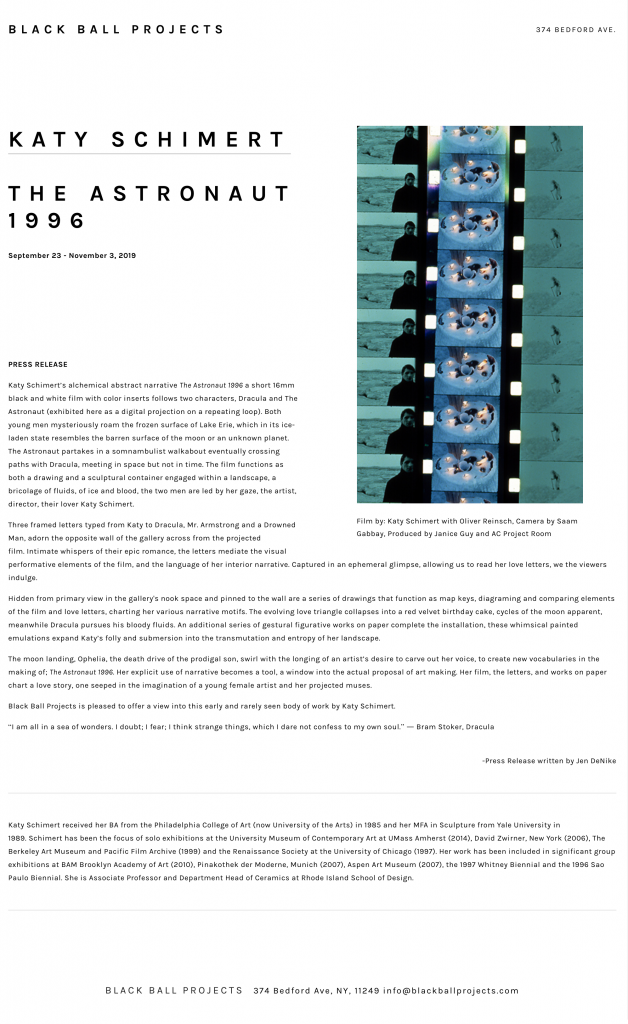
Moon Shot, Moody Center for the Arts
Houston, TX, Sept 20–Dec 21, 2019
Installation Views

Installation view. Photo: N Baker 
Installation view. Photo: N Baker 
Installation view. Photo: N Baker
Individual Works



Press Release
Camouflage, Ink & Silence, University Museum of Contemporary Art at The University of Massachusetts
Amherst, MA, March 27–May 4, 2014
Introduction
This exhibition included eight mural-size watercolors and eight sculptures—four sculptures cast in ceramic and four cast in glass. In the watercolors and the sculptures the octopus is camouflaged within the wave pattern of the sea. The glass and ceramic sulcptures were generated through a three-dimensional computer program to raise and lower the pattern in the watercolor drawings.
Curated by Loretta Yarlow
Catalog available with essay by John Yau.
Glass fabrication: Ross Art Studios
Installation Views
Individual Works

Morning Octopus, 2013, watercolor on paper, 60-1/2 x 95-3/4 inches (153.7 x 243.2 cm) 
Morning Octopus, 2014, ceramic with iridescent luster, 27-3/4 x 8 x 4 inches 
Moving in a Purple Sea, 2011, watercolor on paper, 51 x 90 inches (129.5 x 228.6 cm) 
Moving Octopus in a Purple Sea, 2014, lead crystal, 40 x 35 x 12 inches 
Red Edge in Shallow Water, 2012, watercolor on paper, 60-3/4 x 102 inches (154.3 x 259.1 cm) 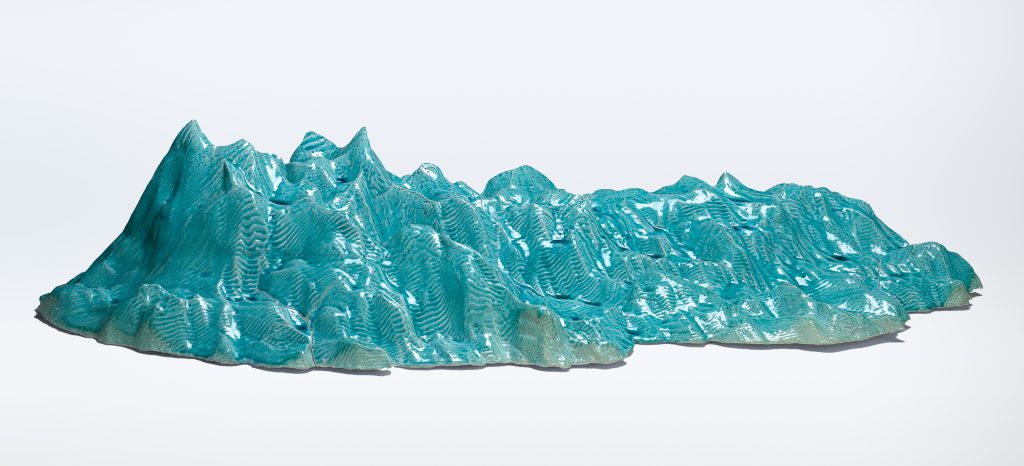
Hiding Octopus in Shallow Water, 2014,glazed ceramic, 38 x 14 x 9-1/2 inches 
Split Octopus, 2011, watercolor on paper, 51 x 107 inches (129.5 x 271.8 cm) 
Split Octopus, 2013, lead crystal, 7 x 15 x 36 inches 
Predator, 2012, watercolor on paper, 60-1/2 x 99 inches (153.7 x 251.5 cm) 
Predator, 2014, ceramic with iridescent luster, 27 x 20 x 7-1/2 inches 
Lurking Octopus, watercolor on paper, 51 x 99-1/2 inches (129.5 x 252.7 cm) 
Lurking Octopus, 2013, lead crystal, 9 x 34-1/2 x 10 inches 
Octopus with Black Ink, 2014, watercolor, 60–3/8 x 95–1/4 inches 
Octopus in a Cloud of Black Ink, 2013, lead crystal, 8-1/2 x 31-1/2 x 9-1/2 
Sleeping Octopus Under a Red Moon, 2011, watercolor on paper, 51-1/4 x 70-1/4 inches (130.2 x 178.4 cm) 
Sleeping Octopus in Murky Water, 2014, glazed ceramic, 25 x 12-1/2 x 5-1/2 inches
Catalog

The Artist as octopus | John Yau
Katy Schimert’s installation, Camouflage, Ink, and Silence, consists of eight large watercolors that measure as high and wide as 100 x 60 inches, as well as eight corresponding ceramic and glass sculptures mounted on low pedestals. Once we enter it we realize that we have entered an underwater environment, that we have gone—metaphorically speaking—below the surface. The subject of each watercolor is a large octopus floating beneath the waves’ faceted surface, while the craggy sculptures evoke the terrain of the ocean floor. The often transparent octopus might be sleeping, hunting its prey, or stealthily moving through the morning sea. The relationship between the octopus and the ocean in which it is floating is ever in flux. At the same time, Schimert does not completely cover the white expanse of the paper with watercolor. Bounded by a contour that can be precise or ragged, her fragment of the ocean is suspended within the white paper’s borders. By underscoring the fragmentary nature of her subject, the artist is able to infuse her segments of the ocean with a contradictory identity; they are both liquid and solid, as if they were pieces of colored glass in which the octopus has been preserved. This duality is integral to both our experience of Schimert’s installation and the meaning of the work. In some of the watercolors, such as Morning Octopus (2013), the artist employs a sinuous line to distinguish the creature from the faceted waves above. In Moving in a Purple Sea (2011), the creature’s contours are barely discernible from the striations defining the ocean’s multi-sectioned surface. Looking becomes an act of refocusing, of picking out a line and tracing it until our eyes complete the form, differentiating it from its environment. Of course, this becomes complicated because the octopus is not a simple form: besides its eight highly flexible tentacles, it is known for its ability to camouflage itself, to become nearly identical to its surroundings. When that happens, looking becomes a kind of excavation as we sift through the visual data, checking it against what we know. While filtering is not the only kind of looking that Camouflage, Ink, and Silence invites viewers to bring to bear, it is certainly one of the most intriguing.
The octopus has long been a subject of fascination and speculation for writers and artists, ranging from Jules Verne, Herman Melville and Marianne Moore, to Hokusai, Pablo Picasso and Steve DiBenedetto. Working in very different forms—writing and art—each of these individuals developed a particular mythology regarding the octopus. For Verne and Melville, it can be destructive, a harbinger of death, while for Hokusai, it was erotic, a bringer of pleasure. The elusiveness of the octopus is part of its mystique. But this is only part of the story. There are also the creature’s unique physical characteristics—an oversized head from which extend eight tentacles (or arms) lined with suckers. Finally, there is the dense cloud of ink that the octopus can release into the ocean, enabling it to escape from danger.
Schimert’s octopus is an expansive vision of the artist, who, in this case works in watercolor and ceramics. It is a stand-in for the creative spirit, and the bonds that tie destruction, camouflage and creativity together in an ongoing process. The octopus becomes a focal point of Schimert’s meditation on the relationship of her materials (watercolor, ink, ceramics and glass) to her processes (drawing, staining, casting, heating and cooling). This is why the act of looking as a form of excavation is integral to our experience and understanding of Camouflage, Ink, and Silence. We not only excavate the form, but we also reflect upon its identity as a solid or transparent thing, as something made out of dried swatches of colored water.
Schimert isn’t satisfied by either an art that is purely visual, if such a thing was even possible, or by one that is essentially social in its concerns. The kind of seeing she is after connects looking outward with looking inward, the gaze merged with reflection. It is an act done in solitude, just as her octopus exists alone in the sea. Furthermore, the question she asks is a fundamental one: what is an artist? Rather than asking, why make art, which is likely to be more socially motivated, fraught with questions of whether art can change people’s lives, she wants to get at something more basic. For all of its human-like qualities, the octopus is other. As the poet Arthur Rimbaud famously wrote to his friend George Izambard on May 13, 1871: “Je un autre” (I is another).
Schimert uses a fine line to divide the constantly changing ocean surface into a series of unique striations, which fit tightly together to form a large, rough-edged, slab-like image, as in Lurking Octopus (2010) and Predator (2012). Within the ocean’s linear rhythms she embeds the contour of an octopus, whose tentacles may extend out or fold in, like an umbrella. The composition of the ocean and octopus requires that she fill in each section individually, carefully applying the watercolor, so that it becomes a stain of color. In order to ensure that she keeps track of the relationship between each part and the whole, as well as part-to-part, she must stay in control of the tonality she applies to each section while paying close attention to its relationship to the adjacent sections. And yet, she must also trust chance, because she is not simply filling in each section in some paint-by-numbers manner. This constant interplay between control and chance is certainly one of the marvels of Schimert’s watercolors.
In Lurking Octopus, for example, the sharp-edged, elongated sections of the ocean’s surface slant down from the upper right toward the lower left corner. Dusky streaks of pink evoke the passing reflection of the setting sun across the turbulent sea. While the ocean’s currents and undulating surface are effectively captured by the painting’s swarming lines and cresting washes of colors, there is a stillness amid its fitted-together sections, as if we were looking at both an image of the ocean and a piece of shattered glass. In fact, as I was looking at Schimert’s watercolors, a most unlikely connection came to mind—Marcel Duchamp’s The Bride Stripped Bare by Her Bachelors, Even (1915–1923), which is often called The Large Glass. It also occurred to me that the glass and ceramic sculptures, with their craggy surfaces and pooling glazes, could be seen both as an echo of the watercolors and their residue, as if the ocean had hardened or molted into these terrains. What ultimately connects the watercolors to the sculptures, however, is the artist’s preoccupation with light, and how to register its different states of immateriality.
The octopus is a creature in which the head and body are one. Philosophically speaking, one could say that it exists in counterpoint to what has been identified as the mind-body problem. In this regard, Schimert’s octopus shares something with the motif of the sperm whale, which Jasper Johns embedded in the vertical lines of the background of his encaustic painting, Ventriloquist (1983). Johns, it should be noted, based his whale on a woodcut Barry Moser made for his illustrations for Herman Melville’s Moby-Dick, published in 1979 by Arion Press.
Like Johns’ sperm whale, Schimert’s octopus is a creature whose mind and body are fused together apparently work in tandem. This represents the largely unattainable ideal of philosophers, such as Ludwig Wittgenstein, who wrote about being in tune with one’s surroundings as well as thinking and doing in unison. In that regard, the octopus is a kind of seer, but one whose body is capable of excreting ink and changing both its surroundings and how it is seen (or not seen). It is both the maker and the instrument of its own perception. In works such as Predator and Lurking Octopus it is evident that in her metaphor of octopus-as-artist, Schimert recognizes the artist’s capacity for destruction, and that art is not necessarily a benign presence.
All of these possible ways of recognizing Schimert’s metaphor are the result of her formal mastery. The watercolors can be said to be explorations of the figure-ground relationship. At times, the figure (or octopus) seems to be on the verge of merging with the ground (the ocean). In other works, the shift from the ocean’s blues to the octopus’ grays is distinctly voluptuous, which is further underscored by the rows of suckers visible on the tentacles. But it seems to me that the most important aspect of the octopus’ identity is its body’s ability to secrete ink (or watercolor) into the ocean. By doing this, the octopus can escape detection, become invisible, which seems essential to Schimert’s imaginative understanding of the ideal artist. She believes that the octopus (or stand-in) is capable of disappearing into its own medium, the constantly changing, watery world it inhabits, and becoming one with it.
One Work, Tang Teaching Museum and Art Gallery
Skidmore College, Saratoga Springs, NY, January 25–June 1, 2014
One Work features nine large-scale artworks from the Tang Collection. Exploring a range of approaches to subject matter and media, the works include recent painting, photography, and sculpture by David Brooks, James Esber, Elger Esser, Anya Kielar, Julian LaVerdiere, Ann Pibal, Katy Schimert, Jonathan Seliger, and Beverly Semmes.
Installation Views

Installation views of The Armored Landscape, 1994, sheet metal and piano hinges, size variable. All photos: Courtesy of The Frances Young Tang Teaching Museum and Art Gallery at Skidmore College


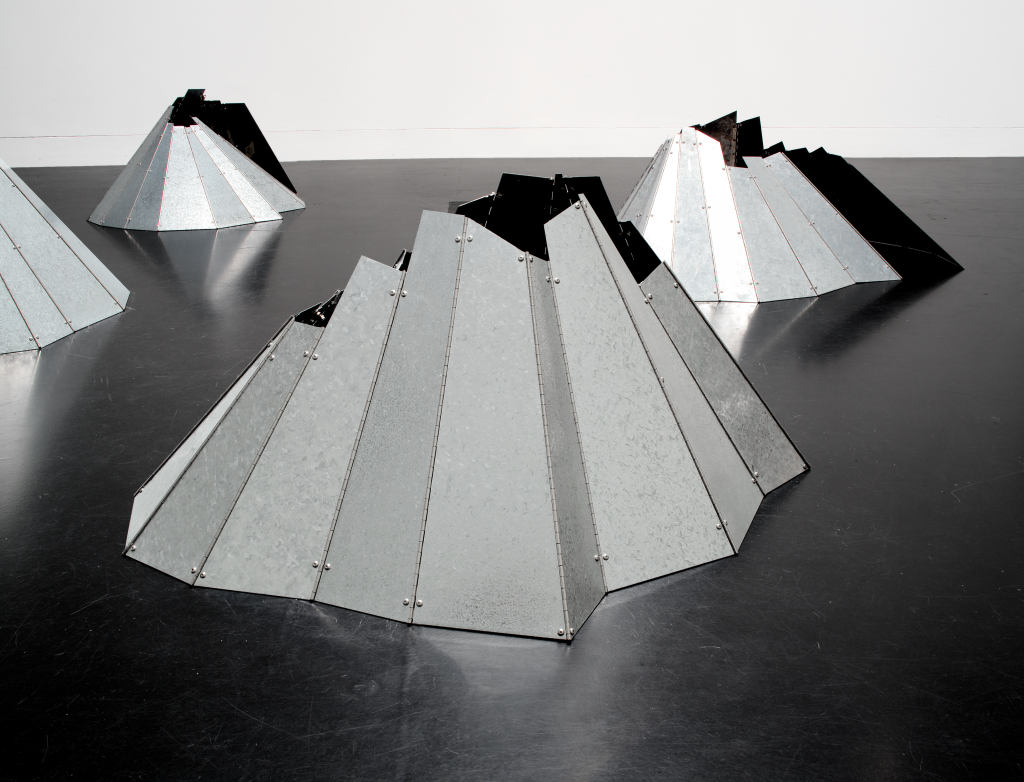






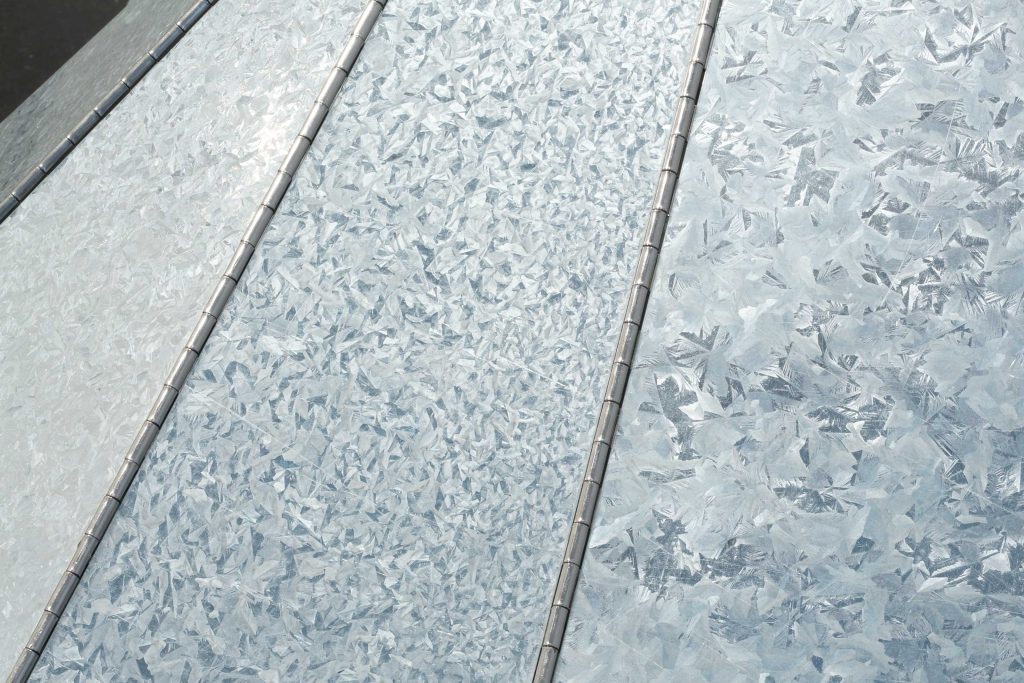
Individual Works

The Armored Landscape, 1994, sheet metal and piano hinges, size variable.



Video Interview
One Work: One Hour
In spring 2014 artist Katy Schimert was interviewed by Skidmore College students Heather Ashe ’14 and Adam Smith-Perez ’14 about her work, Armored Landscapes, 1994, in the exhibition One Work, 2014.
This interview was part of a series of interviews with artists in One Work: One Hour organized and conducted by Skidmore students in the Art History course AH-351A. The series was funded by The Alfred Z. Solomon Residency Fund.
One Work features nine large-scale artworks from the Tang Collection. Exploring a range of approaches to subject matter and media, the works include recent painting, photography, and sculpture by David Brooks, James Esber, Elger Esser, Anya Kielar, Julian LaVerdiere, Ann Pibal, Katy Schimert, Jonathan Seliger, and Beverly Semmes.
These works form the syllabus for a series of artist interviews organized and conducted by Skidmore students in the Art History course AH-351A. The interviews will be recorded and archived to serve as an important source of information on the artists and the Tang Collection for the future.

2010 Next Wave Art, BAM (Brooklyn Academy of Music)
Brooklyn, Sept 21–Dec 2010
Introduction
Curated by Dan Cameron. Installed in the lobby of the Peter Jay Sharp Building.
Originally shown in the 2001 exhibition Body Parts. I began making images about war and the mutilated body initially inspired by ghastly accounts of the Rwandan genocide and photographs of vandalized sculptures after the fall of the Soviet Union. These accounts and images recalled the graphic photographs in Life magazine of the Vietnam War. I was equally influenced by the painting The Raft of the Medusa by Theodore Gericault.
This exhibition included a pile of seventy cast ceramic body parts and internal organs. The surface is a dark metallic glaze with a watery effect.
Installation Views

Untitled (Body Parts), 2001, terra-cotta with black onyx luster, 29 x 109 x 79 inches (73.7 x 276.9 x 200.7 cm). Installation view: lobby of the Peter Jay Sharp Building Brooklyn Academy of Music (BAM)




The Monster, David Zwirner
New York, NY May 28–June 21, 2008
Invite

Individual Works








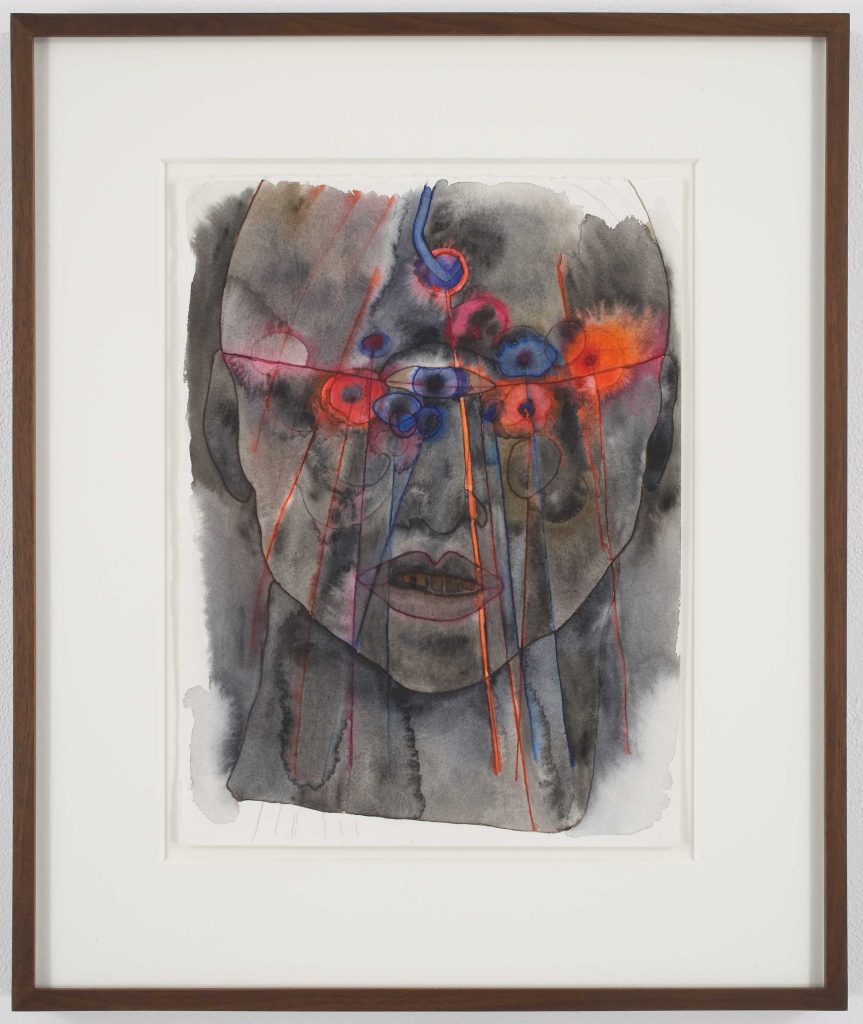




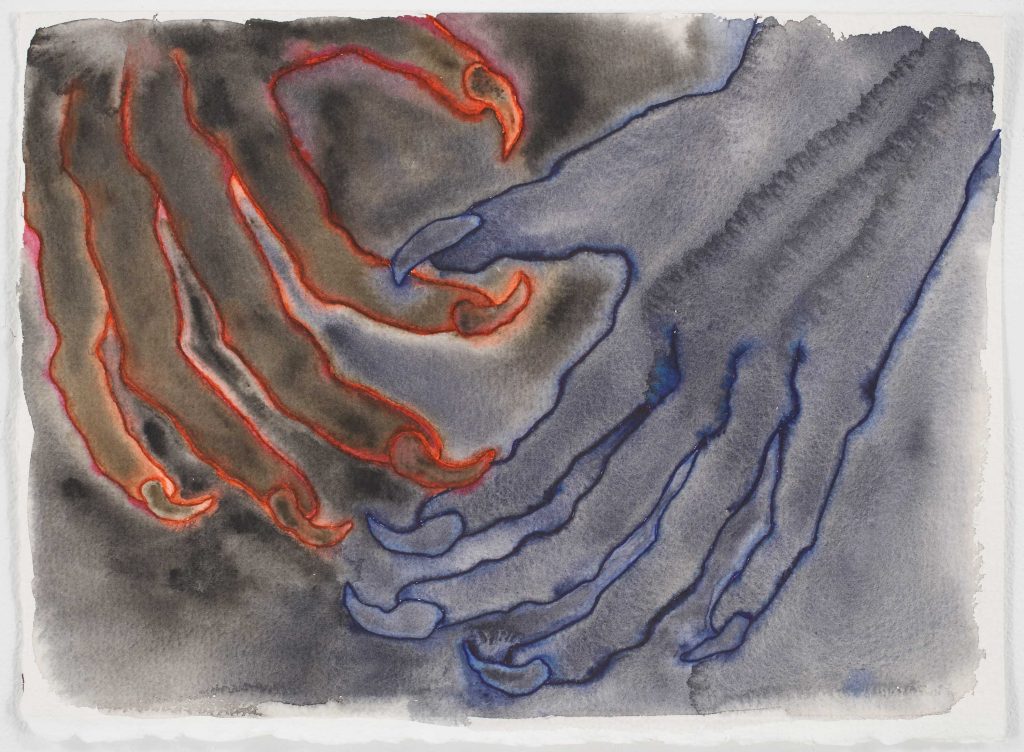
Installation Views
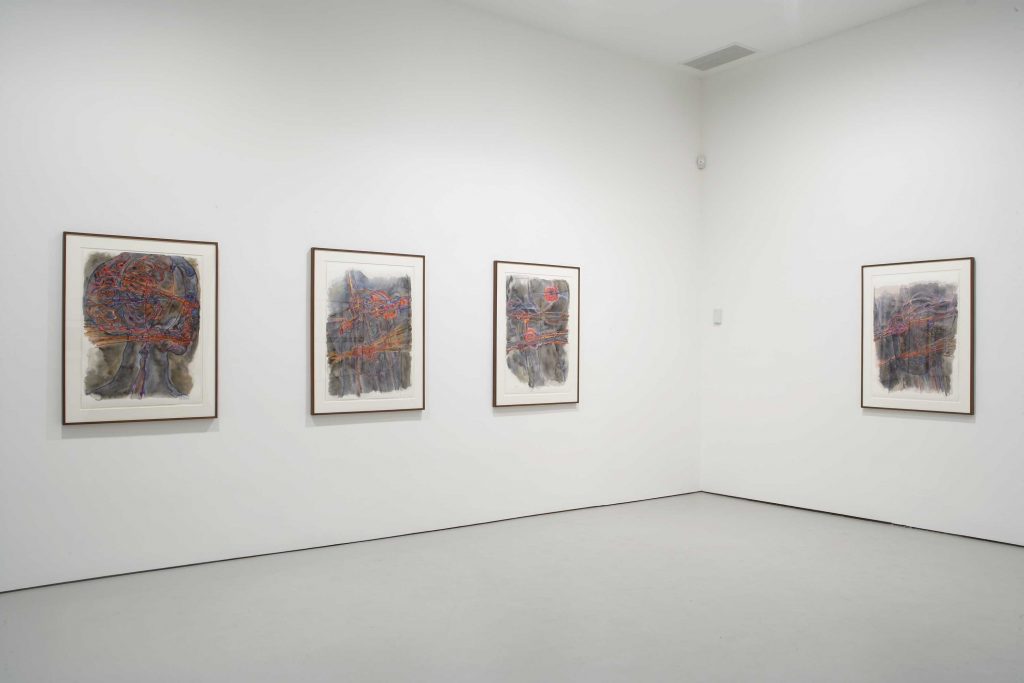
Installation view of The Monster, 2008, David Zwirner Gallery, New York
Installation view of The Monster, 2008, David Zwirner Gallery, New York
Introduction

Alice in Wonderland, Pinakothek der Moderne und Nationaltheater
Munich, Germany, June 28th–July 31st, 2007
Installation Views











Catalog

catalog cover of …drawling, stretching and fainting in coils…, FestSpiele + 2007, Pinakothek der Moderne und Nationaltheater, Munich, 2007




War, David Zwirner
New York, April 7–May 6 2006
Installation Views







Individual Works
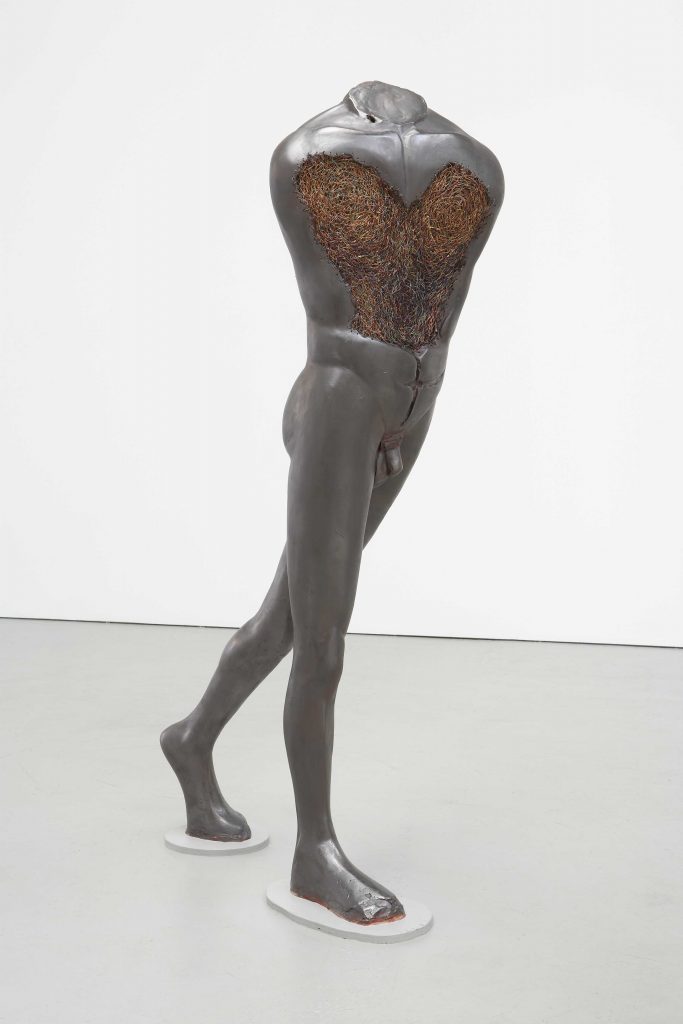

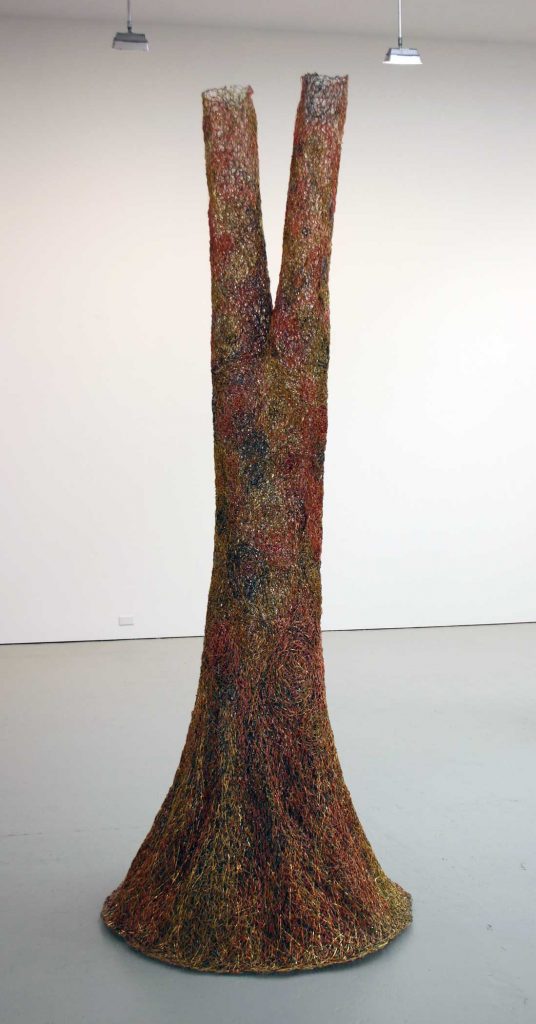

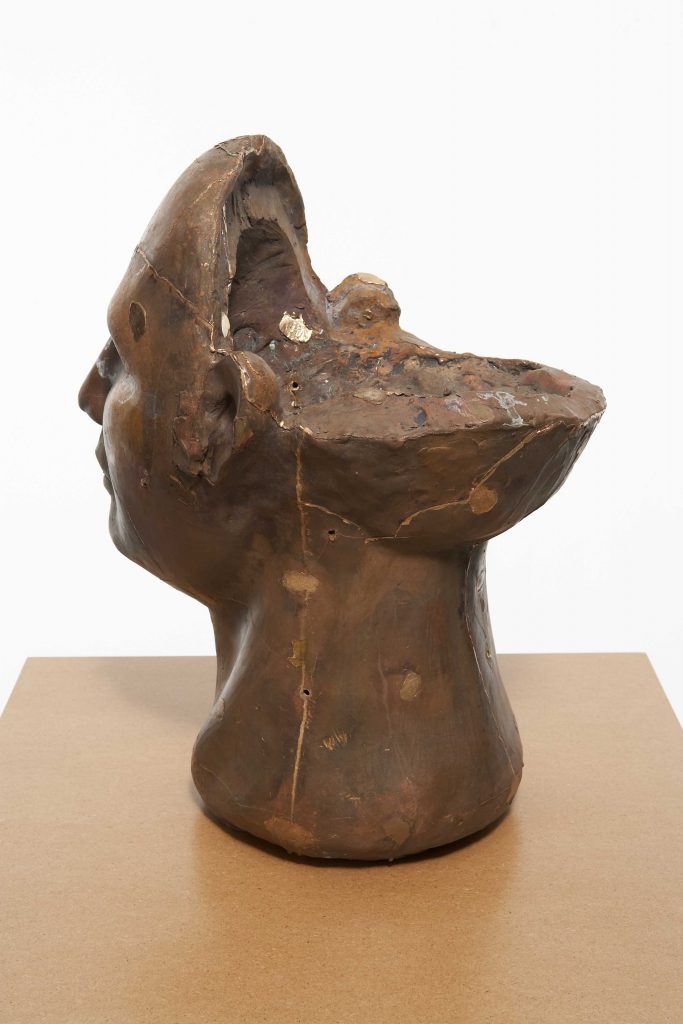





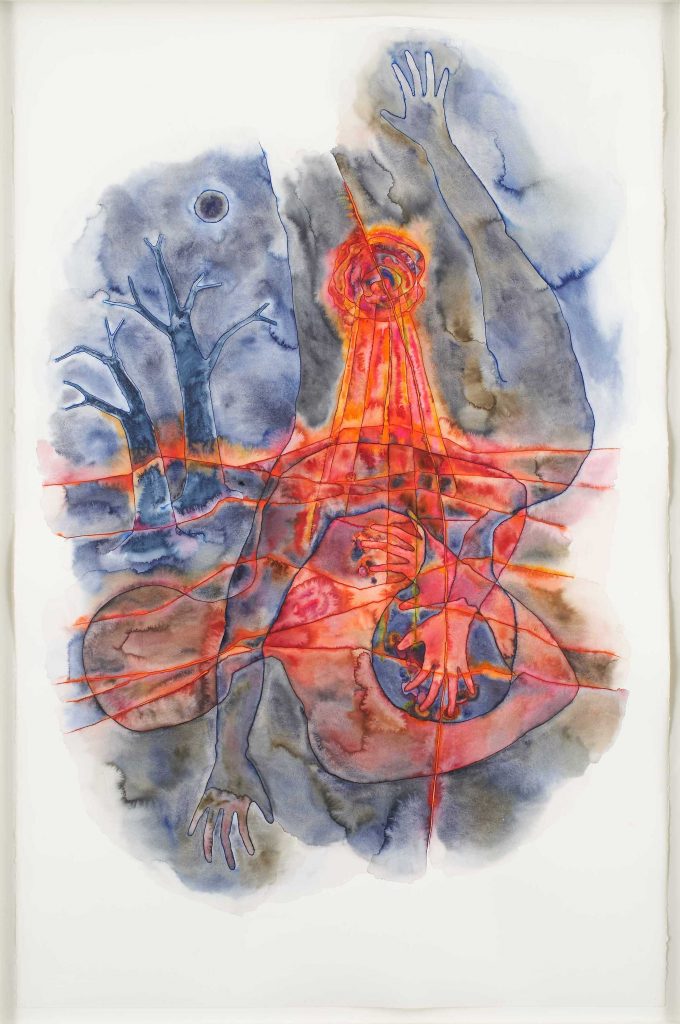

Review

Press Release

Body Parts, David Zwirner
New York, NY, February 10–March 10, 2001
Installation Views





Individual Works












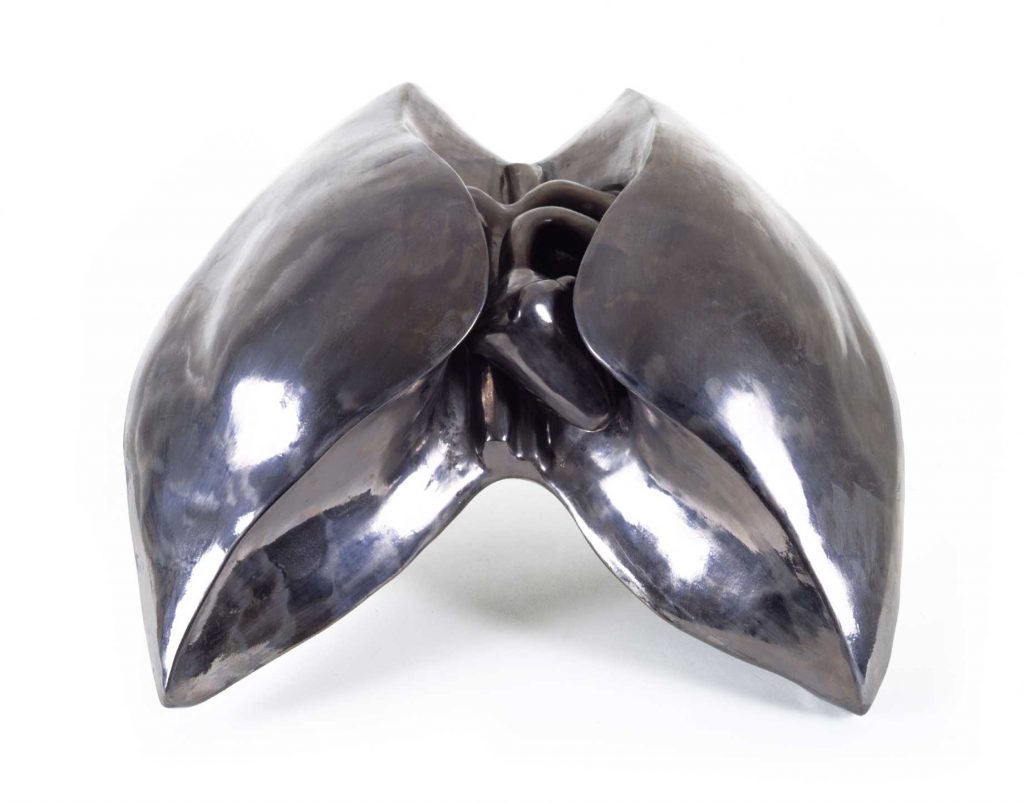




Untitled (one killing another), 2001, ink, watercolor and plastalina on paper, 15 x 22 inches (38.1 x 55.9 cm)



Press Release


